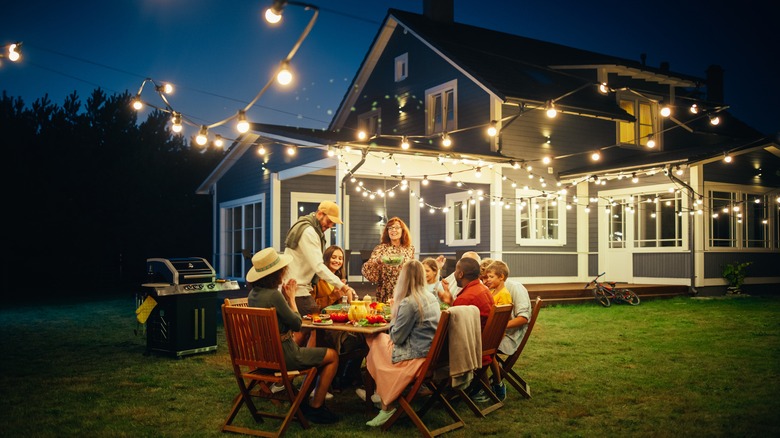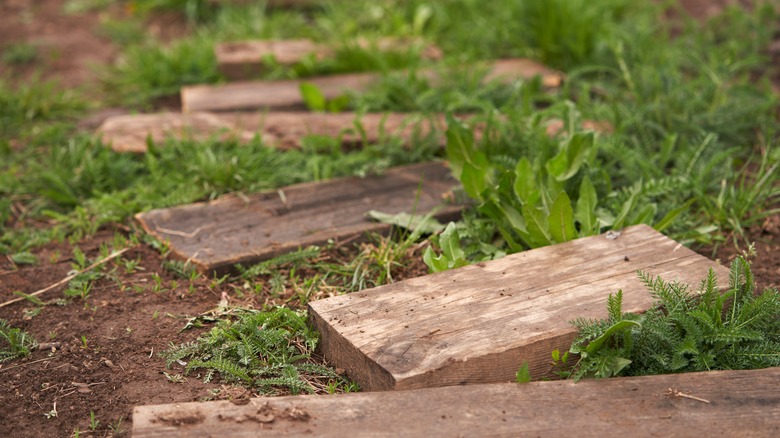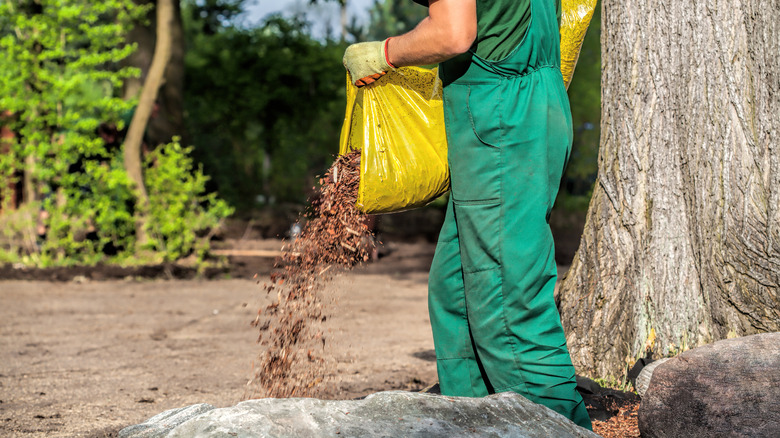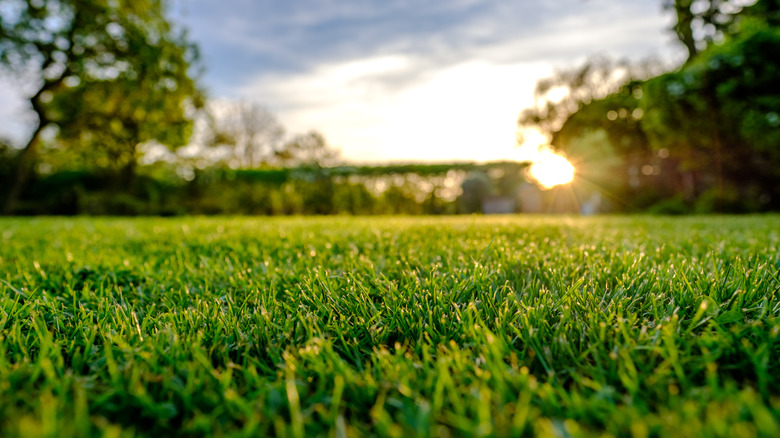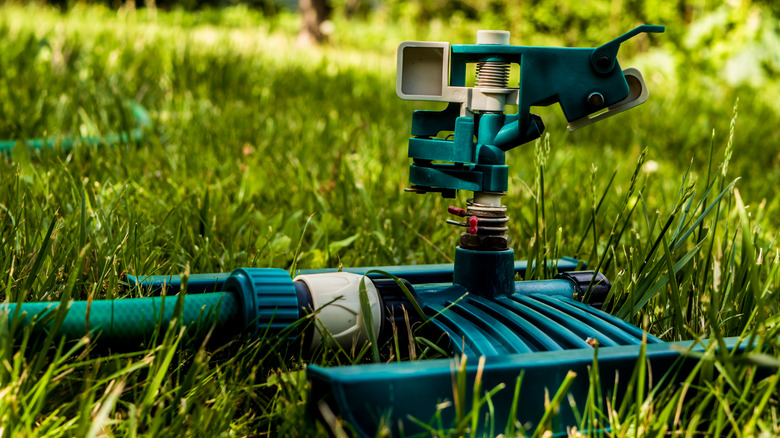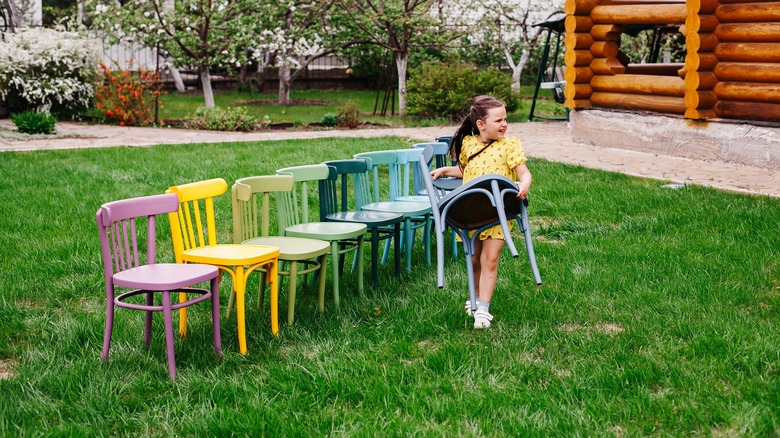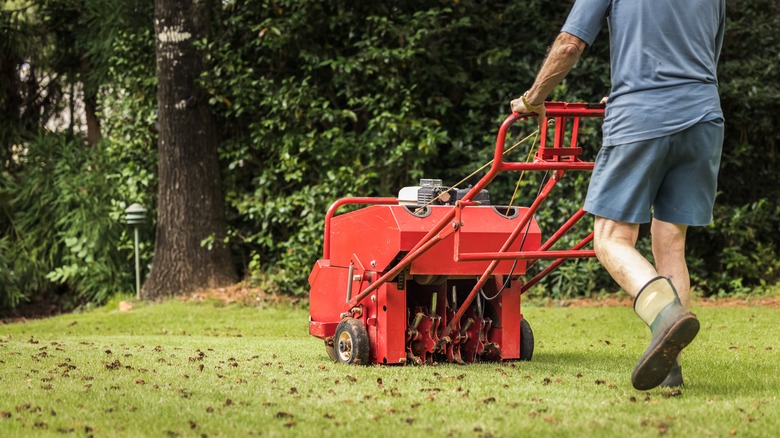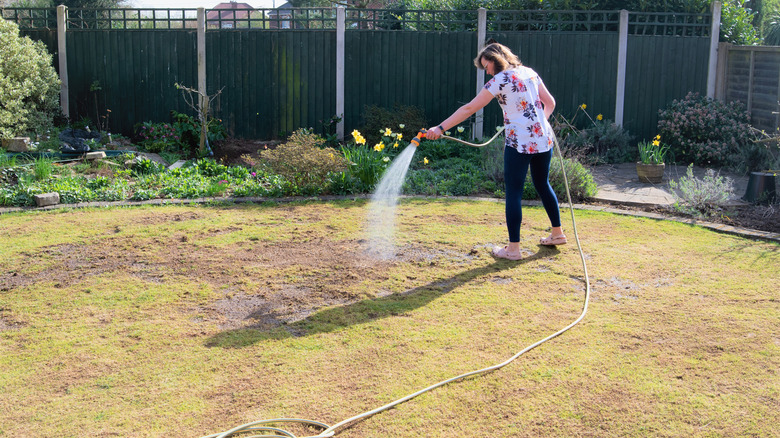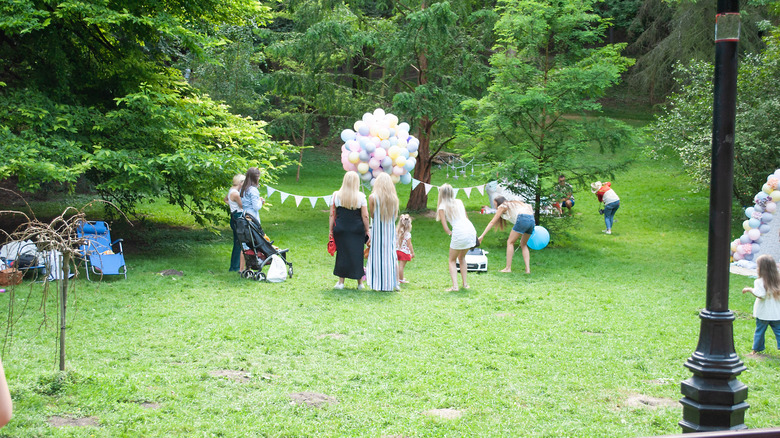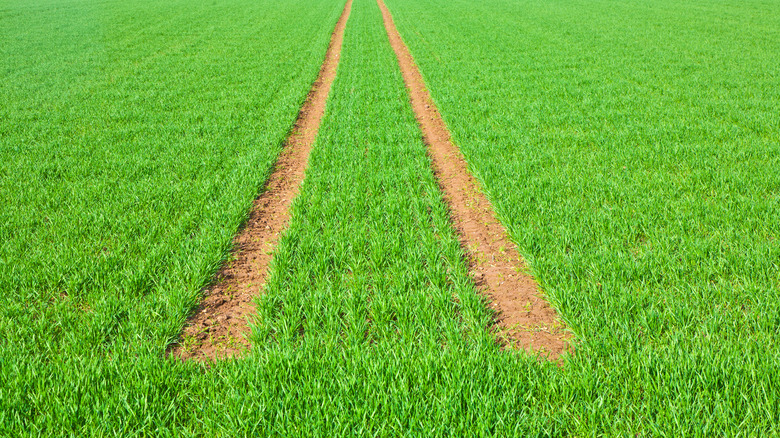Tips For Protecting Your Lawn While Entertaining During Spring And Summer
The warm, sunny weather during spring and summer sets the perfect stage for outdoor gatherings, and your lawn turns into an excellent place to host barbecues, family reunions, or garden parties. However, while you look forward to these events, they can stress your grass. Your parties bring everything from heavy foot traffic to coolers or equipment, which can leave your space looking less than lush. However, there are several things you can do to prevent this stress and protect your lawn, especially if you focus on proactive strategies.
Protecting your lawn is important, and we have detailed, actionable tips to keep your space healthy and the parties going. Whether you want to create a temporary path, adjust your watering schedule around your gathering, or learn how to place decor to minimize damage, we have tips for it all. By using these tailored tips, you can safely host your outdoor bash while keeping your lawn in peak condition all season long.
Create temporary pathways to protect the grass
To protect your lawn during spring and summer parties, create temporary pathways for your guests to wander about. Various materials are available, including portable stepping stones, mulch, or temporary rubber trackways designed to sit on your grass. Walk through your yard and map out where your guests will most likely go, like routes from the driveway to the backyard, patio, pool, or garden area. Lay your chosen materials along these paths to create clear walkways that reduce wear and tear on your lawn.
Creating the perfect DIY garden path to fit your yard before your gathering is critical. When people walk on your grass, it compresses the soil, making it hard for the roots to get air and nutrients. Adding a temporary path at least a day before the event gives you time to adjust before guests arrive. How often you use these pathways depends on how many parties or events you host each spring and summer, but you have to monitor your grass's health when you have them in place. If you notice damage or wear, move the pathways. You also want to ensure you buy lawn and pet-friendly products and secure them so they don't move or stick up as a tripping hazard.
Spread mulch or rocks in high-traffic areas
One of the most important places to use mulch or rocks is high-traffic spots in your yard. Pick areas that get a lot of foot traffic, like the area around your fire pit, seating area, or barbecue grill. Clear any debris or loose grass and spread an even layer of mulch or rocks over these spots. You want it 2 or 3 inches thick for mulch to ensure you have a solid walking surface without it being so thick that it's a tripping hazard. The rock thickness will depend on their size. Whether you pick mulch or rocks depends on your preferences and your lawn's aesthetics. Mulch gives you a slightly softer look and can blend with any flowers or garden beds, but rocks provide a more structured look and last longer.
Spreading rocks or mulch in high-traffic areas helps reduce soil compaction and physical damage to your grass blades from people walking on them. Placing temporary walkways a week or two before your party will give the materials time to settle, lowering the chances of scattering when you walk on them. Depending on the weather and traffic, you may need to add more mulch or rocks in late summer or early fall.
Keep the grass a bit longer to prevent drying out and getting damaged
How often should you mow your lawn, and should you adjust your mowing schedule for your events? Keeping the grass slightly longer can make it look nicer and more resilient. When you mow, set the blade to a higher setting, aiming to keep the grass between 3 and 4 inches long. This will help encourage your grass to grow deeper roots, ensuring access to water and nutrients. Longer grass also bounces back more quickly after stepping on it and shades the ground directly below it, reducing moisture evaporation by keeping it more relaxed. Follow a regular mowing schedule in spring and summer, adjusting based on growth rate and the local weather. The goal is to create a more resilient lawn that withstands more foot traffic without getting crushed.
Adjust your mowing schedule to keep the grass longer months before you first gathering to give your lawn time to grow strong roots. Continue this routine into fall for the best results. Considering that varying grass types have different ideal lengths, it's essential to know which type of grass you have to cut it correctly. Balance is critical because grass that is too long is an excellent spot for pests.
Avoid watering the lawn for a few days before the party
When you're getting ready to entertain, adjust your watering schedule. Stop watering a few days before you host any outdoor event to help the soil get firm enough to withstand foot traffic without compressing. If dry, stop watering two or three days before the event to get the desired effect. You want the soil to be firm enough to handle the increased activity without damage.
Stopping watering before an event will help prevent the space from getting too muddy or soft, and this causes the soil to compact and makes it easier to rip up the grass when walked on. If your lawn is ordinarily healthy and lush, it can survive a short water break without an issue. However, you want to return to your regular watering schedule to prevent drought stress after your event. Keep an eye on the weather conditions; if your region is hot and dry, be more careful with water management. This approach is more effective for spaced-out events rather than for back-to-back ones.
Rotate chairs and tables monthly to avoid pressure spots
Regularly rotating chairs, tables, or heavy objects will help protect the grass if you plan to host gatherings or set patio furniture out on your lawn. Plan a layout that evenly distributes the furniture's weight across your lawn. After a month or every large party you host, move the furniture to a new spot. This could mean you shift the dining area to a different corner or rearrange your seating areas to a new place. The goal is to move the furniture often enough that you don't get pressure spots where the grass crushes and can't bounce back because it doesn't get sufficient air, sunlight, or moisture.
Pressure spots from the furniture or heavy items can cause dead spots where the grass won't recover. Start this rotation early, long before your lawn's peak growth period during spring, to ensure any areas with dead spots can recover. Any location where you move your furniture should be safe and suitable for guests. Avoid putting your chairs or tables on uneven ground where they are unstable or could tip over. Also, consider your yard's entire layout and place furniture to ensure unobstructed access points and pathways. This concept will help you get a unique look for every party or event while keeping your lawn looking as healthy as possible.
Aerate the lawn to improve structure and encourage stronger grass
Learning how to aerate your lawn for healthier grass is essential before party season hits. When you aerate, you poke small holes into the turf that let water, air, and nutrients sink to the roots. This helps boost your soil's structure and encourages more robust grass growth. You can use a manual or mechanical aerator for this process, and the best time to do so will depend on your grass type. However, you'll usually aerate in the early spring or late fall. Mow your grass short and aerate until you cover the whole area. The holes should be 2 to 6 inches apart and 1 to 6 inches deep, and concentrate on spots where your lawn gets heavy foot traffic or has compacted soil to help alleviate these issues.
Aerating your lawn plays a significant role in your grass's overall health and how well it can withstand the heavier traffic of having guests. Improving the air circulation within the soil helps good microorganisms thrive, supporting lush and thick lawn growth. Also, it helps your grass absorb nutrients and water better, encouraging deeper root growth. Aerate the lawn at least once or twice yearly if you have constant, heavy foot traffic or clay-based soil. Aerating in early spring gives your lawn a few weeks to recover before guests arrive. After you aerate, this is a great time to apply a soil enhancer and overseed.
Quickly repair any damaged or bare spots to prevent long-term issues
Look and see how damaged your lawn is after an event so you can address the damage before it spreads. For small spots, rake the surface to remove dead grass and aerate the soil. Spread a thin layer of compost or topsoil to enrich the spots and reseed using a grass seed mix similar to your current lawn. Water the patched area gently but consistently to ensure the seeds get enough water to germinate and grow roots. For a more extensive damaged area, you may need to strip the affected section and replace it with new sod or use a patching product for big spaces. Do this as soon as you notice any damage and after you ensure the weather is good for grass growth to prevent it from getting worse.
Learning the best way to repair damaged patches on your lawn and implementing them will stop them from becoming a bigger issue when weeds take over or the spot erodes. Walking around your yard and inspecting after heavy foot traffic or events will help you spot and fix problems early, keeping your outdoor space looking nice and healthy. Depending on the type of repair you want to do and how bad the damage is, it might take a few weeks or months for the lawn to recover. Ensure you don't walk on the newly established grass often to encourage healthy growth.
Go for lightweight, freestanding decor that won't compact the soil
When hosting a summer or spring gathering, picking the right decor will help save your lawn. Pick freestanding, lightweight pieces that are easy to move and don't require anchoring into the ground. Think of things like fabric flags, inflatable decorations, or solar-powered lighting for the yard. Avoid large planters, heavy statues, or anything you have to stake down because this can cause soil compaction and damage the grass. Focus on finding items that can sit on your lawn's surface without putting too much pressure or that you can hang from fences, trees, or temporary structures.
Picking these decor pieces is essential for helping you keep your lawn in good shape throughout the spring and summer. Heavy decorations restrict water and air from getting to the roots, and this can cause patchy growth or brown spots. You will have to plan for this tip, especially if you're used to having more heavy-duty decorations. Source your decor a few months or weeks before your event to ensure it arrives in time. However, since they are lightweight, you must place them securely around the yard so they don't blow over or cause an accident.
Designate parking areas so guests don't drive on the lawn
Designate specific parking areas for guests to prevent vehicle damage to your lawn. The areas should be away from your yard to prevent people from driving over the grass, which can cause soil compaction and damage to grass blades. Use cones, signs, or temporary fencing to direct guests to the correct parking spots. If you don't have enough space in the driveway, consider asking your neighbors if they have space to spare or look into local parking alternatives. Give clear instructions on the invitations or put up signs at the property entrance. The goal is to keep vehicles off the lawn without confusing your guests.
Driving a vehicle over the grass compacts the soil, making it hard for roots to get nutrients, water, and air. This can cause the grass to turn yellow, wilt, and die, and it can be hard to treat these patchy spots. Plan for parking weeks before your event because this gives you time to arrange for parking alternatives if you need them. Be aware that some guests may not see anything wrong with parking on the grass, so communication is vital. Also, ensure your parking spaces are accessible for everyone, including anyone who needs closer access because of mobility issues or uses a mobility aid. This will help your lawn stay vibrant while ensuring guests can easily get to your party.

